Big, is good!
Posted on August 17, 2017
Over the last two weeks here at the residency I have been assembling the full scale pieces of the playspace modules. As is always the case, easier said than done, but after some hefty DIY engineering solutions, I have some life size things to play with.

The choice in the use of that materials has made it very easy to source and build, with the average build time of a module around one hour for prep and cutting, around one hour for assembly – that is at a pretty leisurely pace! It is fantastic to see these pieces take shape and being able to reflect back on the process that has lead to this design, and the origins being the board games. All the pieces, the way they fit together and the way they play together have strong feelings of a giant game set. The pieces look, feel and play like a family, or kits set, open to new interpretations.
In the previous post I discussed how they could all fit together in a larger playspace, very much like a giant board game. Being able to look at the pieces and the layout like this, really reflects the origins of the project, and is a great way to talk about how each module exists on it’s own as a design, and how they fit together as part of a greater whole. And so it begins…
Module 1
To recap, this is the main structural component to the game. From here, many components can be assembled to create the pathways as desired for play. The routes can be set up in maze forms, guiding players around the space as they see fit.
The module comprises of two pieces of identical design. A framework of connected pipes acts as a barrier that creates the walls of the pathways. This module can be arranged as one big curve, or switched so that it forms and “S” shape. Either way, the module adheres to the overall pattern it needs to fit to match the others pieces in the design. Each end has a peg, with an attachment that connects the two pieces of the module. From here, more and more versions of the module can be connected to form the greater pathways in the playspace.
Module 2
This module acts as the anchor in the design. It has the ability to change it’s direction, but on the spot, rather than moving around. This can change the direction of the maze pathways if aligned with Module 1, which can develop into new versions of the games played. The module can also act on it’s own when combined with various similar modules, creating circles and cages for various uses and play.
The module is built with a sturdy base, a tyre in this case, an axel through the middle, a bicycle wheel as the turning mechanism, and finally large lengths of pipe to create the shape. Tabs are added on the top of the structure to stop the mechanism from spinning continuously, so that it can be set into a still desired position.
Module 3
This design has become quite a fun part of the space. Although it doesn’t “click” together like the other pieces, it starts to work together as a destination piece that breaks the rhythm of the pathways. After testing this with some kids, it has developed into quite a fun part of the gameplay itse
The design consists of very easily assembled parts; a tyre at the bottom for standing and for holding the weight, four poles attached through the tyre with plungers, four straps to hold everything in place, and four loops at the top, two big, and two small. The original game play is to have one of these modules per person, and try and loop the bigger circles over the smaller ones of the opponent. Since then, with some tests, the kids have made their own games, trying to throw balls through the hoops, while one person in the middle shakes the poles do iodine the balls. The module has also been used as a “castle” in the centre of the maze, a sort of “safe-place” from enemies.
Module 4+5
These two modules are in the next step of development. In the test group with the kids we talked about how these could fit together with the whole design, what their purpose is, and how they could be developed. The kids seemed fairly excited about the Alignment module, that would allow them to unlock certain parts of the maze, and the components involved. We also played a lot with the 5th module, in terms of its use around the space. The kids devised a fair amount of ways it can be used and incorporated into the games, for which I will make the developments for the next test.
As far as all the pieces being electronic in some way goes, this will be the next phase. All the parts still have their inherent interactive nature, and this will only further extend as the project develops. In the next post, I bring a small team of 10-12 year old critics to come and test, evaluate and suggest how the project can develop. A true sharks-den if there ever was one!
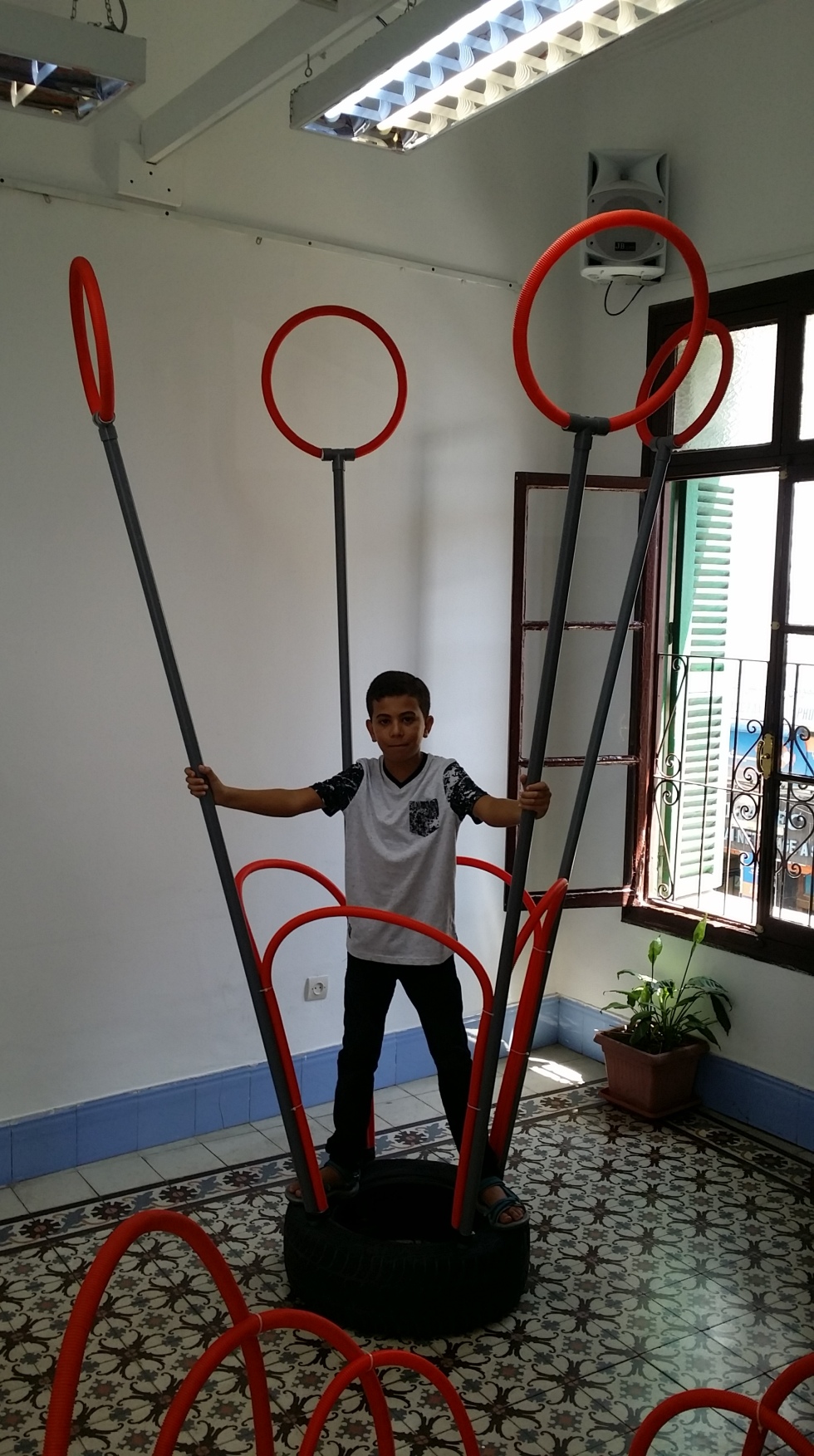
Making things
Posted on August 10, 2017
Since the previous post I have taken some time travelling through the rest of Morocco, and doing a bit of tourist ventures. From riding camels in the Sahara dunes, to driving through acres of Palm tree valleys in the Atlas Mountains. It was a whirlwind trip, a bit touristy, but amazing nonetheless. Taking a break from the design work was a good move, no massive epiphanies, but a fresh start last week proved somewhat fruitful.
I’ve managed to go through a pretty extensive development phase for each of the designs, and they are all finally one happy family. I have shifted a couple of the modules to fit together more in the whole design, rather than being elements on their own. Now, the entire play space, consists of modules that can be manipulated and added together, much like giant Lego pieces, to create a play space.
I’ve spent the last week building scale models to investigate all the designs spatially, and how they fit together as a family. As far as the design goes, I’m really happy and excited to get building the full scale prototypes, however as I’ve been collecting materials to build these full scale versions, I’ve come across some very interesting obstacles. What I have in my mind, and the reality of what is available are two different things. But alas, that’s what this project is all about. Being able to create the design, from locally accessible materials. So for that part, there is success, albeit it being difficult. The only stumble block at this point is including the digital/electronic component in the ways I had imagined. These would most likely need to be reconsidered once the full scale versions are built. The interaction remains the same, it’s really the output of this interaction, that would be the last component.
So, right now, the play space is designed, and can be built through these various modules. As in the images above, the entire space is starting to fit together really well in the modular way I intended. I’ll give a quick rundown of each, and show some examples of how I have toyed with the idea of how they might fit together. The entire layout is based on a hexagonal grid, where all the pieces can fit together on this grid.
Module 1 – Route
This module is the basis of the play space. Keeping in mind that the whole idea for the play space is to create pattern based manipulated pathways, this piece becomes the foundation piece. By arranging and connecting them kids can create routes and mazes. All the other pieces/modules become an extension from this piece.
This module is designed to fold in half, so that combined with other similar ones, they create various routes. The can fold forwards and backwards, connecting, closing and redirecting the pathways, as in the main layout image a bit earlier.
Module 2 – Entrapment
A maze needs a trap, and this module serves that purpose. The ends reach the same distance as the points on the first module, and then based on the hexagonal grid, they can block or narrow the the maze routes, and create new games and avenues.
The module can rotate with ease, to change the way that it is aligned to the rest of the pathway, again, as per layout diagram above. I will show more detailed versions of what I imagine this could be in a special next post.
Module 3 – Racing
As much as this module is called racing, it’s just where it originated. Right now, this I would consider more of an obstacle course/building block. This piece again extends the same distance as the other pieces on the hexagonal grid, but can change its shape. The middle section can roll back and forth and be placed on its side, and multiple version can be stacked together. Very much, a flexible building block.
The vertical tyres have an axel through the middle, and can roll/slide along the strop back and forth. This allows the pieces to be adjusted in shape, to be added and moved around it’s counter parts
Module 4 – Hunting
I laugh now at the names I gave these modules… As much as it helped at the beginning it seems very unnecessary now. I think I’ll just go with a numbering system from here on. This Module “4” takes on a bit more of a destination in the bigger scope of the play space.
It can be climbed through, used as a “cage” or connected at the top with similar modules and become something completely different – perhaps – even a castle… Ha!

Module 5 – Alignment
So for this module, things are slightly different. It is more of an intimate game in itself, rather than an overall piece. A sort of centerpiece if you will. I am still in the process of deciding whether this is the right option to take, or whether it should be more of a Lego piece like the rest of the play space. Decisions decisions, the bain of my existence.
This will be a central game, where the purpose is to rearrange the wheels to complete a pattern. the initial starting point will determine the pattern to be created. in the middle will be a light of sorts, once you connect your pattern, you connect a circuit (if it’s correct) and the light turns on. First one to complete the pattern, wins. Currently I’m just deciding whether to stick with the game format, or move it more to a larger physical interaction. I do however enjoy the fact that in the larger play space, there is a smaller more intimate play mechanism.
As I launch into a very strange building process, I’ll keep adding posts about the progress. Let’s see where it ends up!
Devoted to Pattern
Posted on July 25, 2017
You just cannot spend time in Morocco and not be completely seduced by the overwhelming amount of patterns, sacred geometry and geometric features the country is so known for. Everything from floor tiles, wall tiles, carpets to curtains. Even manhole covers and grates over vents have beautiful intricate patterns creating some very unique images. To say this has not been an influence in where this project is heading would clearly just not be true.
As for the projects, so far I have managed to develop 4 out of 5 of the sections. As I mentioned in the previous post, my goal is to loosely base the overall Playspace on the structure of a Moroccon pattern. I have now develop 4 of these areas into opportunities for play, but constructing and manipulating pathways and patterns. Each, also including some form of modularity and interactive movement.
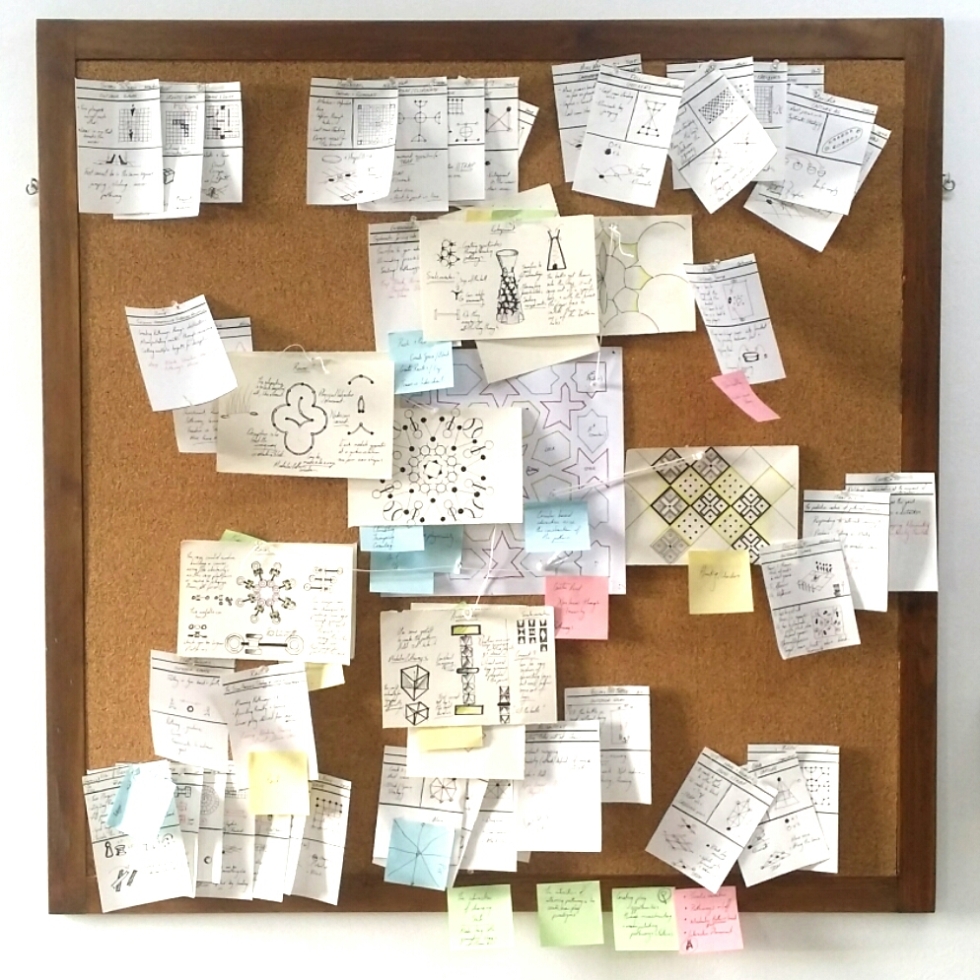
At this point I am just playing with concepts, have not properly resolved the electronic components yet either, but this is all to come in the following weeks, as I build the prototypes. As I’ll explain below, each of these are just the “concept” and not the final design. From here, as I start building and experimenting, it is very likely that these concept will change quite a bit, in terms of build, design and practicality. The concept, the interaction, will stay the same, just visually, some things will change. This will also be the start of working with the tech. Each one of these designs have come from extensive analysis from the board games, listed in terms of their strategy, a research question posed, a small guided brief written for each, and then the designs formed from that.
Route Section – Red component in the pattern
Derived from games that are all about creating pathways, blocking pathways through deception and manipulating routes through mirroring, this image shows the concept as it sits at the moment. The modular component is a third of a circle, that can bend both ways in the middle. Through this format, and repeating the module, it is possible to create a maze of pathways. So far, I imagine somewhat of a forest of uprights on these slats, to hide the pathways, and add to the deception of the maze. Technically, unresolved as of yet, especially how it all fits together, and the electronic/digital component that will be used to encourage interaction and manipulation.
Racing Section – Blue component in the pattern
The racing design so far derived from all the racing board games is quite the tricky one. This design will probably be quite easy to make from big tyres and straps, which would be ideal. The game itself, is designed to be a bit of a manual obstacle course, where each of the circles are pads that can be run and jumped on, jumped over. The objects on either end can be pulled in either direction with the strap, or shifted around the side to create pathways. The centre shape can also be twisted on it’s side to create a higher part to jump on
Alignment Section – Orange component in the pattern
A bit of a change in tempo, as this one is more of an intimate game compared to the two earlier examples. In this game the aim is to complete a three in a row based on patterns. The patterns themselves on the inked of the structure will end up being quite 3 dimensional. In terms of electronics, the wheel in the middle is designed to be attached to a kinetic energy motor, powering the structure. As pieces are connected in the right order, they light up, finally lighting the last section indicating who won. Ha, maybe not as sprightly forward, but it’s nice to pretend! This shape has some issues in terms of height, construction and design, but as an overall concept, could work very well
Entrapment Section – Brown composed in the pattern
Again, aiming to design something a bit more intimate and low key, the game is to guide a ball from the top to the bottom into a specific little trap. Each of of the little pattern shapes is meant to be manually rotated, so that the player can guide the little ball down to where the need it to be. A shape at the top, releases the balls once thrown in. It would be quite interesting not knowing where the balls might come out, and if the top spinners are a bit too high to reach, the ball could take a very strange journey down. Again, it needs some work in terms of the final layout, but all in all, heading in the right direction.
That’s where the design sits at the moment. The fifth category is still en route to becoming something more formalised, so for now, it’s just a massive array of scribbles on paper.

Having worked my way completely through one sketchbook in just two weeks, it’s perfect timing to take a little break. I’m heading out to Marrakech this evening and making our way back through the Atlas mountain. Maybe, just maybe, some fresh mountain air might just notch that final one into place.

Getting into the heat of things
Posted on July 20, 2017
Halfway through week 2 and things are steaming along, so I thought it a good time to start logging the progression before I skip too far ahead!
After all the research from last week, collecting around 40 board game strategies, I went about organising them into categories. By enlarge, most board games fall into one of 5 “types” of conceptual gameplay. At least, as far as the 40 games I researched. These 5 types in my wording are; Route Games, Entrapment Games, Hunting Games, Racing Games, and Alignment Games
The project is specifically created to use modular components to create a larger Playspace, and Morocco’s patterns and designs lends itself to just this sort of modular assembly. In a lot of the Islamic Sacred Geometry this modularity is quite recognisable, from how patterns nest together over larger surfaces all the way through to how specific patterns on tiles add to greater geometries. I have researched and mapped a few of these patterns in my time here so far and deconstructed them in an attempt to find the underlying structure and modular sections – with success!
The plan is to deal with each of the 5 game “types” as a section of the larger Playspace, which I have divided up according to a very standard Moroccon pattern. These 5 sections then will be divided in their own modules, can exist as separate spaces themselves, but will also be a part of the greater whole Playspace. So in effect, the overall design will be about creating pattern based play opportunities through constructing and manipulating pathways.
So for now I have taken each of the 5 game “types,” analysed and conceptualised, and assigned a pattern to each. These are the starting points for the design concepts. The following is what came from the research, and where i’m going with it. I won’t put in all the bare bones of the process, as it is probably not the right reading material in a blog, but I will tease away with some pictures of where each section is heading.
Route Section
Creating routes by seizing opportunity through deception.

Entrapment Section
Systematic forcing into a trap
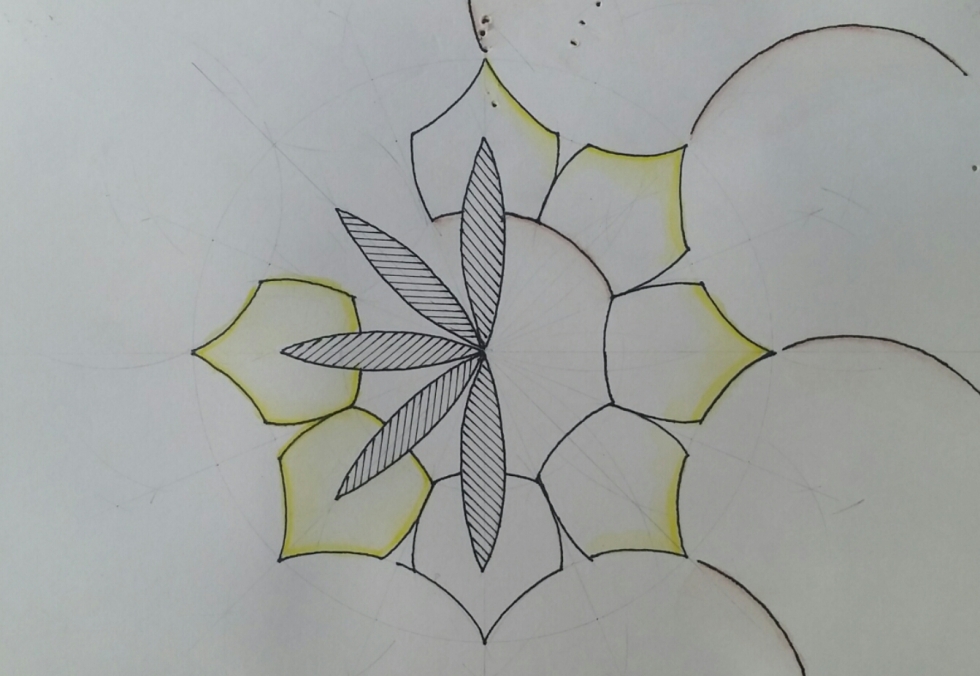
Hunting Section
The predictive nature of patterned movement

Racing Section
A simultaneous strategy of creating advantage and sabotage

Alignment Section
Sculpting order out of chaos through constant shifting

So there it is, a little bit of that. All things going well by the weekend I will be deeply into some of the designs, so I will make a big update post around then again, and share some of the ideas.
The Game’s On!
Posted on July 15, 2017
First week down at the residency and I am starting to settle in quite a bit here in Tetuoan. It has been a pretty full week already; language lessons, artisan tour and drawing classes to name a few.
But alas! Not all fun and games… The project must go on, and so it has. Week 1 was all about games research, and so it happened. With a pin board of nearly forty games researched, learnt, analysed and drawn the design bit is about to commence!
From here next week is going to be all about pulling out the bits and pieces and putting together some designs that will start to resemble play spaces! For now, some pictures, next week there will definitely be some meaty design to write about.
Morocco Interactive Playspace Project
Posted on June 16, 2017
In July & August I’m heading to Morocco to build another PlaySpace for kids. This PlaySpace will be a digitally interactive PlaySpace, made modular and with recycled materials so that it could be open-source, rebuilt and replicated anywhere, by anyone, especially in the developing parts of the world.
I’m funding this project in the next 30 days through a crowd funding campaign on PlaygroundIdeas, and need your help through this. It would be great if you could donate to the project, and share it with your friends and family who might be interested and could help as well:
>> CROWDFUNDING PROJECT PAGE LINK <<
If you could give towards this project to help me achieve this funding goal, and get the project out to these communities, that would be amazing! If not, even sharing it would help a lot, and it would help me to share this project around once it’s completed and provide more kids with fun interactive PlaySpaces!

Performance Arcade Call for Proposals out
Posted on June 17, 2014
I have been a part of this Arcade for a long time, and it’s time to get the ball rolling again! This year we are presenting and curating a video installation series. Call is open to both local and international artists, have a look find it here: Call for Proposals
Pasefika at Circa theatre
Posted on April 6, 2014
Now that the New Zealand Festival season has wrapped up here are some pics I took as we built the show during rehearsal. Lots of projection, lots of wicked sound, strong design!
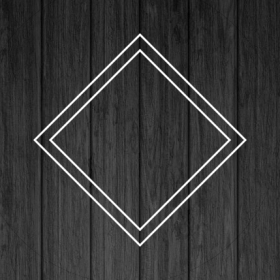































































































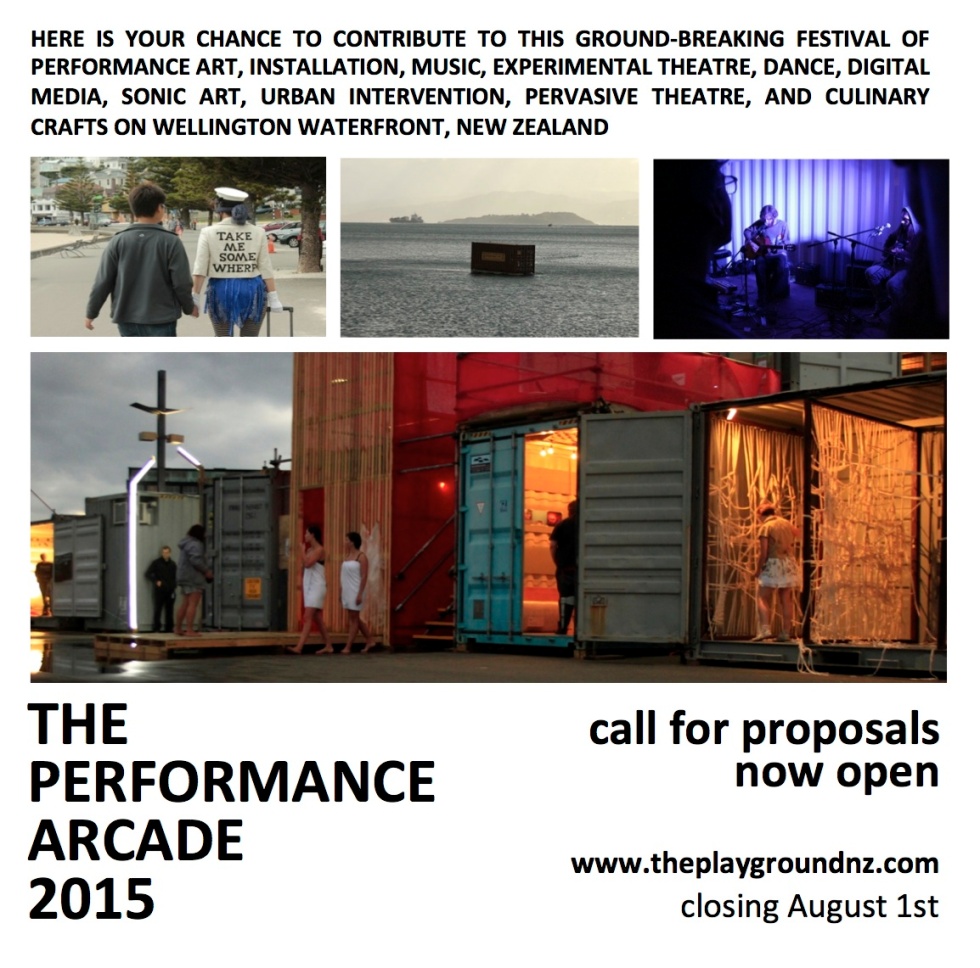
You must be logged in to post a comment.